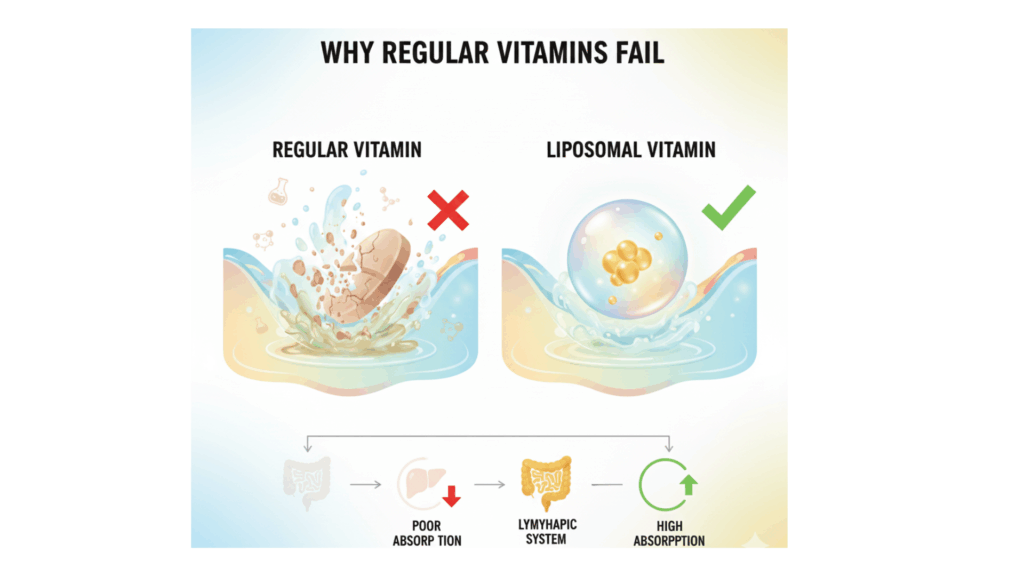Physical Address
304 North Cardinal St.
Dorchester Center, MA 02124
Physical Address
304 North Cardinal St.
Dorchester Center, MA 02124

When it comes to absorption, the difference between liposomal vs regular supplements is far bigger than most people realise. Regular vitamins often break down in the stomach before your body can use them, while liposomal forms protect nutrients inside tiny fat-based bubbles so more reaches your bloodstream. If you want supplements that actually deliver noticeable results, understanding this difference is the key.
Quick Summary
Regular supplements often lose a large share of their nutrients in the gut before your body can use them. Liposomal supplements protect vitamins inside tiny fat-based bubbles, helping more of each dose reach your bloodstream and your cells. That is the real difference between just swallowing a pill and actually feeling a change in your energy, immunity, and recovery.
Featured Snippet:
Regular supplements can fail because stomach acid and digestive enzymes break down most of the nutrients before they are absorbed. Liposomal supplements use fat-based capsules called liposomes to shield vitamins during digestion and then fuse with your cell membranes. This improves absorption and gives stronger, more reliable results from the same or even smaller doses.
You swallow your multivitamin, a vitamin D capsule, and maybe vitamin C when you feel a cold coming on. You do this for weeks or months, but your energy, focus, and skin stay more or less the same. Blood tests still show low levels of vitamin D, B12, or iron.
The problem is usually not your willpower or even the brand. The problem is how much your body can absorb.
Most standard oral supplements have to pass through a harsh digestive system before they ever reach your bloodstream. Along the way, stomach acid, digestive enzymes, and what is called first-pass metabolism in the liver can reduce the amount of active nutrients that finally become available to your cells. You can see this explained clearly in pharmacology discussions of oral drug absorption and the first-pass effect here.
In other words:
What you swallow is not what your body receives.
This is why two people can take the same tablet, but one feels better and the other feels nothing. The difference is not who “tries harder”. The difference is who absorbs more.
The word liposomal comes from two Greek words:
Liposomal supplements are simply nutrients packed inside very small spheres made from phospholipidsthe same natural fats that form your cell membranes.
These spheres are known as liposomes. Under a microscope, these tiny carriers look like small bubbles, with the nutrient (such as vitamin C or magnesium) safely enclosed inside.
Their outer layer is built from phospholipids that your body already uses to repair and strengthen cell membranes. Because the structure is familiar, your system recognises these carriers easily and absorbs them more efficiently. Scientific reviews describe liposomes as biocompatible and suitable carriers for both drugs and nutrients.
In simple language:
Revised step-by-step explanation (no repetitive sentence starters):
Here is what happens inside your body:

Here is what typically happens to a standard tablet:

For water soluble nutrients like vitamin C, absorption is limited by specific transport proteins in the gut. Once those transporters are saturated, extra vitamin C simply passes through and is excreted. This transport limit has been described in detail in vitamin C pharmacokinetic reviews vitamin C transport and limits.
For fat soluble vitamins like A, D, E, and K, lack of healthy dietary fats can block absorption. This is especially relevant in Indian diets where people may eat low quality fats or try to avoid fats completely, while these vitamins actually require some good fat in the meal.
Add to this:
Even if the label shows a high dose, the usable dose inside your cells may be quite small if the path to absorption is weak.
Liposomal technology did not start as a wellness trend. It was first developed in pharmaceutical research to deliver powerful drugs to specific tissues while reducing side effects. Liposomes have been studied for decades as carriers that can improve how drugs dissolve, travel in the body, and reach target cells. General liposome overview.
Because these same challenges exist for fragile nutrients, scientists began exploring liposomal delivery for vitamins, antioxidants, and other bioactive compounds. The goal is the same:
This is already being studied for oral vitamin C and other antioxidants, where liposomal formulations can show improved stability and tissue delivery compared with plain forms enhanced vitamin C delivery.
So when you see a liposomal supplement, you are looking at a nutrition product that borrows a delivery system originally built for serious medical use, adapted now for daily health support.
If you live in India, there is another layer to this story. Several large reviews show that vitamin D deficiency is extremely common in India, even though sunlight is abundant. Estimates in different regions suggest that a very high percentage of adults have low vitamin D levels vitamin D deficiency in India.
Vitamin B12 deficiency has also been reported frequently, especially in populations with low animal food intake and high reliance on vegetarian diets vitamin B12 status in India.
In reality, lifestyle and absorption work against us:
So when someone says, “I tried vitamins, they do not work,” the real question is:
How much did your body actually absorb, given your daily routine?
This is exactly the gap liposomal formats try to cover. They cannot fix your entire lifestyle, but they can help your body use more of what you are already taking.
As liposomal supplements become more common, it’s important to know how to use them effectively and what makes them truly different from regular vitamins:
Even the best formulation will underperform if taken the wrong way. A few simple habits can help you get the full value from a liposomal supplement:
Liposomal delivery gives you an advantage, but consistency still does most of the work.
If you remember only a few points from this comparison, let it be these:
Because your body may be absorbing only a small part of each dose, stomach acid, enzymes, and liver metabolism can reduce how much reaches your bloodstream. General oral absorption overview.
Research on compounds like vitamin C suggests that liposomal forms can reach higher blood levels than standard forms at the same dose, indicating improved bioavailability and enhanced vitamin C delivery.
Not always, but liquids and liposomal formats can sometimes avoid some of the breakdown steps that solid tablets face. The real question is the quality of the formulation and how well it survives digestion.
Liposomal forms can be gentler because the nutrient is protected inside a fat-based carrier, but it is still important to speak to your healthcare provider.
The stomach is designed to break down food with strong acid and enzymes. This environment can damage sensitive nutrients if they are not protected oral and gastric environments.
Phospholipid-based liposomes are generally considered safe and have been used in drug delivery for many years liposome safety review. Always follow label directions and discuss long term use with your doctor.
Yes, most people can, but it is better to keep a one to two-hour gap between them and to check with your doctor if you have any medical conditions.
Some liquid products do, especially in hot climates. Always read the storage instructions carefully.
Many use phospholipids from sunflower or soy, which are plant-based. Check the label for the specific source.
In many cases, they can be a good option, especially where digestion and absorption are weak, but people with existing health conditions should always seek medical advice first.
No. They can support your nutrition by improving absorption, but they cannot replace home-cooked meals, fruits, vegetables, lentils, good fats, sunlight, and movement.
For many people, it can take two to four weeks of steady use to feel changes in energy, immunity, or recovery. Blood markers often take longer to shift and should be checked with your doctor.
This article is for general awareness and educational purposes only. It is not intended to replace professional medical advice, diagnosis, or treatment. Always speak with your doctor, nutritionist, or another qualified healthcare professional before starting any new supplement or changing your diet or lifestyle.